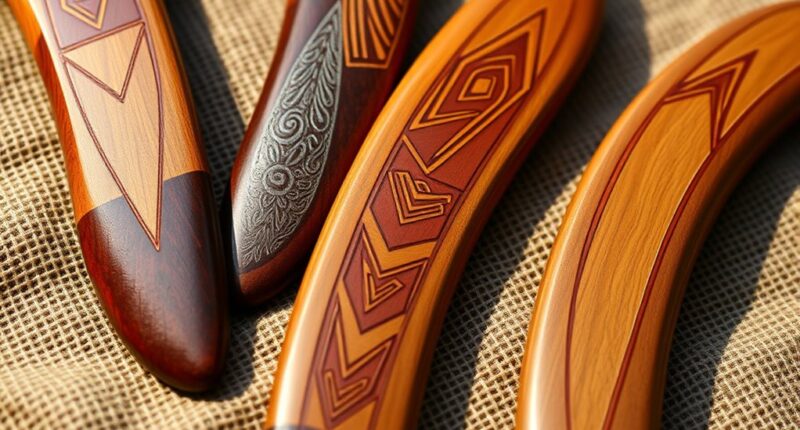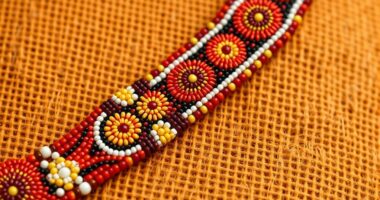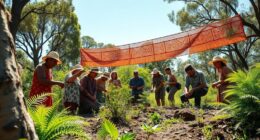Carving boomerangs and woomeras is a skilled craft that combines artistry with tradition, reflecting deep cultural significance. You select native timbers and shape them with precision to guarantee both functionality and beauty. Decorations often include intricate symbols and motifs that tell stories or provide spiritual protection, turning each piece into a cultural artifact. Respecting ancient techniques, these tools carry stories passed down through generations, and exploring further reveals even more about their fascinating craft and cultural role.
Key Takeaways
- Traditional carving combines artistic motifs with functional design, reflecting deep cultural stories and spiritual beliefs.
- Skilled artisans select native timbers for their specific properties, ensuring durability and proper aerodynamics.
- Decorations using ochre pigments encode symbols, stories, and tribal identities, transforming tools into cultural artifacts.
- Crafting techniques emphasize precision, balancing form, function, and symbolic artistry passed through generations.
- These tools serve as living symbols of Aboriginal heritage, preserving ancient traditions and Dreamtime legends through craftsmanship.

Have you ever wondered how ancient Australians crafted their iconic hunting tools? It’s a fascinating process rooted in tradition, skill, and a deep connection to culture. Aboriginal art isn’t just about paintings and carvings; it’s also reflected in the craftsmanship behind traditional tools like boomerangs and woomeras. These tools weren’t merely functional; they held spiritual and cultural significance, often decorated with intricate patterns that told stories or conveyed symbols from Dreamtime legends. When you carve a boomerang or woomera, you’re participating in a centuries-old tradition where art and utility intertwine, honoring ancestors and preserving cultural identity.
Ancient Australian tools blend art, culture, and function, honoring traditions and Dreamtime stories through intricate craftsmanship.
The process begins with selecting the right timber, often from native trees like mulga or witchetty. You need to understand the properties of each type of wood—density, flexibility, and durability—to guarantee your tool performs well and lasts. Aboriginal art influences how you shape and decorate these tools; traditional motifs, symbols, and ochre pigments are used to embellish their surfaces. These decorations aren’t mere decoration but serve as a form of storytelling, spiritual protection, or identification of tribal origins. As you carve, every cut and engraving reflects a deep respect for the materials and the cultural stories embedded within them.
Carving a boomerang requires precision and an understanding of aerodynamics. You carve away excess wood carefully, shaping it into a curved form that can return to you when thrown correctly. Woomeras, on the other hand, are designed to extend the reach of a spear, providing leverage and accuracy. Both tools demand not only skill but also a connection to tradition, ensuring that each piece is both functional and culturally meaningful. The craftsmanship involved is meticulous; you must balance the form and function, sometimes adding painted designs or symbols using traditional ochres. These markings can signify tribal affiliation, spiritual protection, or hunting success, turning each piece into a portable piece of aboriginal art.
Creating these tools is more than just making hunting implements; it’s an act of cultural preservation. When you carve and decorate a boomerang or woomera, you’re continuing a legacy that dates back thousands of years. You’re respecting the techniques handed down through generations, honoring the stories woven into every line and motif. The skills involved are passed through oral tradition, with knowledge of carving, painting, and spiritual significance shared among community members. In this way, traditional tools become living symbols of Aboriginal art, embodying both practical purpose and profound cultural meaning.
Frequently Asked Questions
What Materials Are Traditionally Used for Carving Boomerangs?
You typically use traditional woods like mulga, witchetty, or yew for carving boomerangs. These woods are lightweight, durable, and easy to shape. You might also incorporate natural dyes for decoration, which come from materials like ochre, charcoal, or clay. Using these natural materials connects you to cultural traditions, making each boomerang not just a tool but a meaningful piece of art and heritage.
How Do Cultural Beliefs Influence Boomerang Designs?
Imagine a boomerang as a woven tapestry of spiritual symbolism and ancestral stories, each curve whispering traditions. Your designs are deeply influenced by cultural beliefs, embodying sacred symbols and stories passed down through generations. These patterns serve as a bridge to ancestors, honoring their spirits and teachings. By carving with intention, you keep their legacy alive, transforming each boomerang into a flying story that echoes with cultural meaning.
What Tools Are Essential for Beginner Boomerang Carving?
To start carving a boomerang, you need essential tools like wooden templates to shape your design accurately, and carving knives to refine the details. These tools help you create smooth curves and precise edges, making your boomerang functional and aesthetically pleasing. Always choose sharp knives for safety and efficiency, and use templates to guide your work. With patience and practice, you’ll craft a quality boomerang that reflects your skill.
How Is the Aerodynamics of a Boomerang Tested?
You test a boomerang’s aerodynamics by analyzing airflow simulation and spin stability. Did you know that a well-designed boomerang can return 90% of the time? To assess its flight, you observe its spin stability and use wind tunnels or computer models to simulate airflow. These methods help you optimize shape and angle, ensuring smooth, predictable returns. This process enhances your understanding of aerodynamics and improves your carving skills.
Are There Modern Innovations in Boomerang Craftsmanship?
Yes, modern manufacturing has introduced innovative materials like carbon fiber and lightweight composites to improve boomerang performance. These advancements allow you to craft more durable, precise, and aerodynamic boomerangs. You can experiment with different shapes and designs using computer-aided design (CAD) software, optimizing aerodynamics. This fusion of traditional craftsmanship with cutting-edge materials and technology results in a more consistent, high-performance boomerang for enthusiasts and professionals alike.
Conclusion
As you carve each boomerang and woomera, you become part of a living thread in a rich cultural tapestry. Your hands shape more than wood—they craft stories, traditions, and connections that soar like the very tools you create. These handcrafted pieces aren’t just objects; they’re echoes of centuries of ingenuity and spirit. So, keep your tools steady, and let your craftsmanship carry the legacy forward, like a song carried on the wind.









